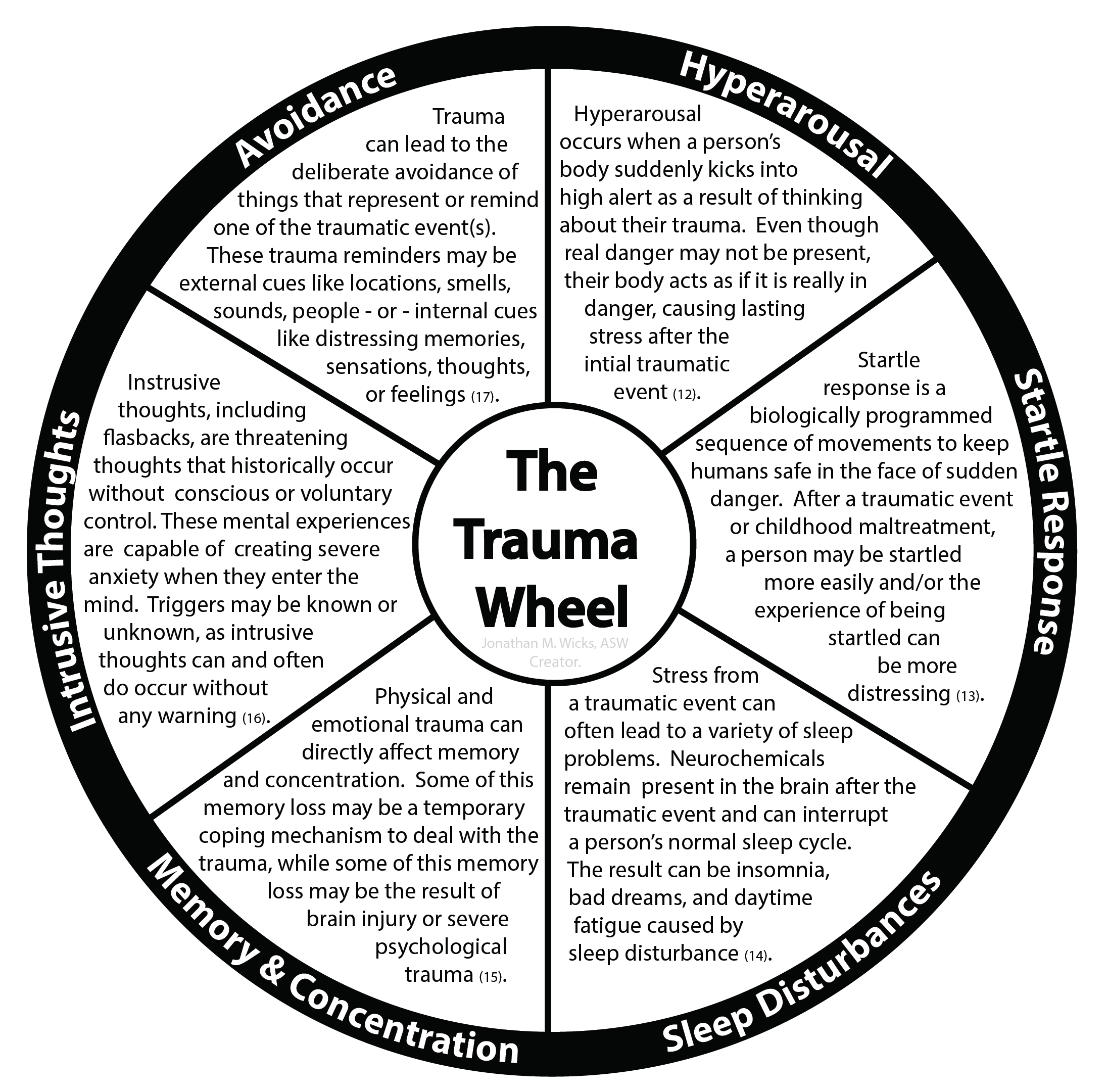Brief Psycho-
Education on Trauma
The impact of trauma.
If you have been exposed to trauma, this Trauma Wheel is intended to bring understanding to things you may have experienced or are currently experiencing since the traumatic event happened. Sometimes, the symptoms of trauma can be perceived as normal struggles in life, when in fact they can be traced back to the trauma.
The 12-month prevalence of PTSD in the United States is 6.8%, while the lifetime prevalence is 3.6% for men and 9.7% for women (1, 2, 3). Intimate partner violence contributes to the trauma population, as one study found that domestic violence fueled 22% of violent crimes committed against women and 3% of violent crimes committed against men (4). Another study found that 94% of rape survivors met the symptomatic criteria for PTSD shortly after the assault, while 47% met the criteria three months later (5).
There are many causes of trauma, ranging from natural disasters, medical conditions, serious injuries, vehicular accidents, community violence, racism, bullying, or combat-related trauma. Whether it is sexual violence, physical violence, or emotional violence, many people are affected by trauma.
The estimated lifetime prevalence of PTSD among American Vietnam Veterans was found to be 15.2% for men and 18.1% for women (6). The estimated prevalence of PTSD among Gulf War Veterans was found to be 10.1% (7). The prevalence of those deployed to Iraq and Afghanistan for service were found to be 13.8% (8).
Research also shows that complex trauma follows exposure to chronic trauma from childhood, which can manifest as issues with attachment, affect regulation, biological regulation, dissociation, cognition, and self-concept (9). Not only does trauma cause biopsychosocial-spiritual-cultural problems over the course of a person's life, but data shows that adverse childhood experiences (ACES) can lead to negative health outcomes like chemical dependency, heart and liver disease, intimate partner violence, obesity, and suicidality (10).
Everyone responds to trauma differently; what was traumatic for one person may not be traumatic for the next. Share this resource with those that have survived a traumatic experience, or to those who care for someone exposed to trauma. Without exposure to psychoeducational material on trauma, the common symptoms that follow trauma may be perceived as something other than what they are - trauma.
Other Common Responses After Trauma
Fear
Self-harm
Chronic exhaustion
Low self-esteem
Diminished creativity
Anger
Inflated self/ego
Minimizing
Addiction
Sense of persecution
Guilt
Numbing
Hopelessness
Helplessness
Physical ailments
Pessimism
Difficulty with listening
Difficulty with empathy
Difficulty with complexity
Dissociative moments
Understand changes in the brain.
You are not “crazy” - you are traumatized. They are not “crazy” - they are traumatized.
If you can remember that trauma has an impact on the neurobiology of the survivor, the common symptomatology caused by exposure to trauma will be easier to recognize, understand, and manage.
Trauma initiates the survival response in a person. The amygdala is essentially the alarm system of the brain, and trauma can cause the amygdala to become overactive and cause a person to be overly stimulated with the feeling of danger, even when they are in a safe space.
The other areas of the brain that would typically help suppress these amygdala-driven feelings of danger have been shown to become less active after exposure to trauma, which can also be the cause of many of the distressing symptoms a person experiences after surviving a traumatic event.
Use the graphic of the neurobiology of trauma to better understand many of the common responses after exposure to trauma.
Know the symptoms.
There are many symptoms that may follow a traumatic experience. Being able to manage the impact of these symptoms starts with learning how to recognize the symptoms, and using skill to decrease the impact on daily functioning.
Learn the skills.
There are several skills that can be learned to help manage the maladaptive impact of trauma. It’s not possible to erase one’s history, but it is possible to learn new skills to help manage the present.
Seek additional support.
TF-CBT, CBT, EMDR, and other resources exist to help facilitate the journey of healing. There is nothing wrong with seeking additional services and support to help manage life after trauma exposure.

